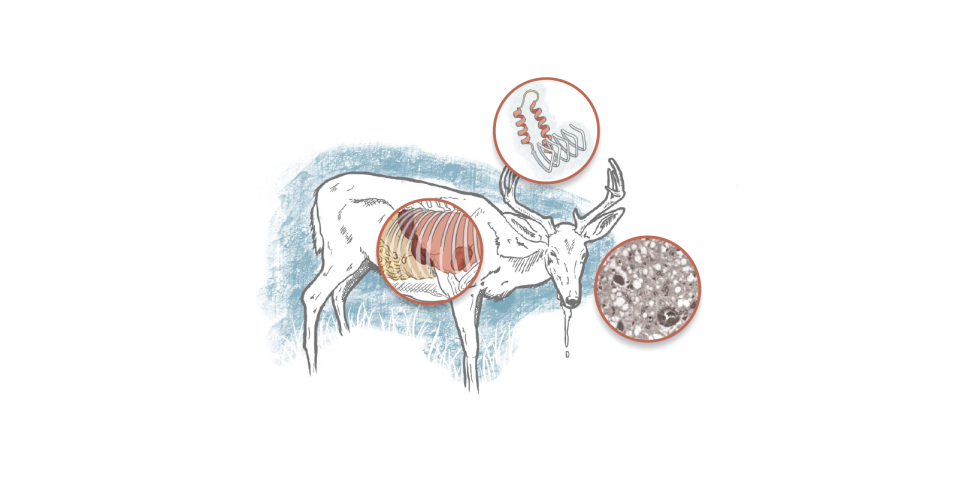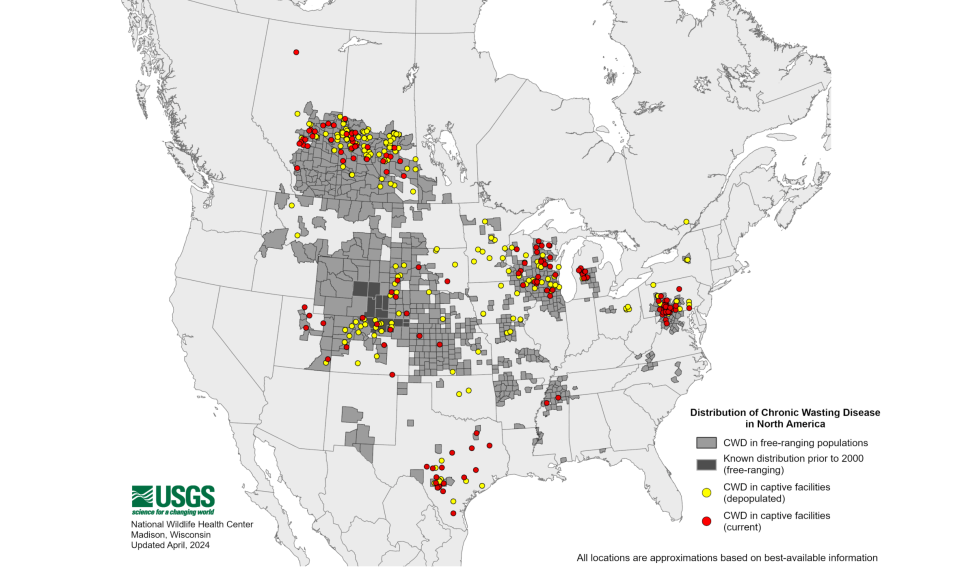2 die after eating CWD-infected meat: What to know about 'zombie deer disease'
Researchers reported the death of two hunters who ate venison infected with chronic wasting disease or "zombie deer disease," raising questions about whether the disease may be transmissible to humans.
Chronic wasting disease is a progressive, fatal prion disease that affects the brain, spinal cord and many other tissues of farmed and free-ranging deer, elk, and moose.
CWD earned the nickname “zombie deer disease” for associated symptoms including weight loss, lack of coordination, stumbling, listlessness, weight loss, drooling and lack of fear of people.
According to previous reporting by USA TODAY, scientists and health officials have been concerned that CWD could eventually adapt to infect humans as mad cow disease did in the United Kingdom in the 1990s. In 2022, scientists in Canada published a study suggesting a risk of CWD transmission to humans.
Here's what to know about the case, and whether you should be worried about CWD.
More: 13 more CWD cases found in NC: What to know about 'zombie deer disease'
2 men die after eating CWD-infected venison
A study published on neurology.org said that in 2022, a 72-year-old man with a history of consuming meat from a CWD-infected deer population presented with rapid-onset confusion and aggression, USA TODAY reported. His friend, who had also eaten venison from the same deer population, recently died of Creutzfeldt-Jakob disease, a human prion disease. The researchers said this raises concerns about a potential link between chronic wasting disease and human prion disease.
Researchers didn't reveal where the two men were located, but highest concentration of CWD-infected deer have been found in Kansas, Nebraska, Wisconsin and Wyoming according to CDC and US. Geological Survey reports.

What is 'zombie deer disease'? What are prion diseases?
The CDC states that CWD is a prion disease or transmissible spongiform encephalopathy. Other TSEs include bovine spongiform encephalopathy or “mad cow disease” in cattle and scrapie in sheep and goats.
The North Carolina Wildlife Resources Commission says the following can spread CWD:
Live deer, including newborn fawns
Whole deer carcasses
Anything containing brain, spinal cord, nerves or lymph nodes
Body fluids
They have also asked N.C. residents to avoid placing out food for wildlife, as the regular gathering of deer to feeding locations can increase the risk of CWD transmission.
Learn more about CWD Regulations in N.C. here.
Where has chronic wasting disease been detected?
USA TODAY reported that CWD has continued to spread over the years, and was found most recently in Indiana. The disease was detected in April in a male white-tailed deer in the northeastern part of the state, which borders part of Michigan, where CWD had been detected earlier, according to the Center for Infectious Disease Research and Policy.
The U.S. Geological Survey updated its tracking of chronic wasting disease on April 19 to include 33 states (adding Indiana), as well as four Canadian provinces and four other countries (Finland, Norway, Sweden and South Korea).
As for N.C., there have been 24 total cases recorded since the disease was first detected in Yadkin County in 2021. This includes 13 new cases announced since July 1, 2023.

CWD surveillance in NC
The N.C. Wildlife Resourced Commission announced April 23 counties that are in CWD surveillance areas.
Primary surveillance areas:
Cumberland
Stokes
Surry
Wilkes
Yadkin
Secondary surveillance areas:
Alexander
Alleghany
Ashe
Bladen
Davie
Forsyth
Guilford
Harnett
Hoke
Iredell
Robeson
Rockingham
Sampson
The news release also noted that any hunter who harvests a cervid within following dates and counties is required to submit a sample for testing to the Wildlife Recources Commission not later than two weeks following the harvest:
November 23-25, 2024: Alexander, Alleghany, Ashe, Davie, Forsyth, Guilford, Iredell, Rockingham, Stokes, Surry, Wilkes and Yadkin counties.
November 16-23, 2024: Bladen, Cumberland, Harnett, Hoke, Robeson, and Sampson counties.
More: 'Zombie deer disease' cases are rising in the US. Can the disease spread to humans?
Is CWD possible in humans? What is the human equivalent of CWD?
Creutzfeldt-Jakob disease, which appears as rapidly presenting dementia, is often called the human form of mad cow disease. CJD is rare but fatal. The UK NHS lists possible symptoms including loss of intellect and memory, changes in personality, loss of balance and coordination, slurred speech, vision problems and blindness, abnormal jerking movements and progressive loss of brain function and mobility. CJD usually causes fatality within a year of the symptoms’ onset.
Researchers including Dr. Sabine Gilch, Ph.D., associate professor and Canada Research Chair in Prion Disease Research at UCVM, believe that the neurology.org study presents some unsettling evidence that CWD infection in humans may be a possibility.
“This is the first study to show that the barrier for CWD prions to infect humans is not absolute and that there is an actual risk that it can transmit to humans,” Gilch said in an article from the University of Calgary.
The CDC also states that it is important to keep the agents of all known prion diseases from entering the human food chain.
Mike Snider, USA Today, contributed to this article.
Iris Seaton is the trending news reporter for the Asheville Citizen Times, part of the USA TODAY Network. Reach her at iseaton@citizentimes.com.
This article originally appeared on Asheville Citizen Times: CWD: Can humans catch zombie deer disease, chronic wasting disease?

